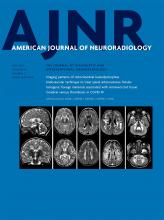We read the recent publication by Shlapak et al,1 “Time to Resolution of Inadvertent Subdural Contrast Injection during a Myelogram: When Can the Study Be Reattempted?” with interest. The extrathecal injection of contrast during a spinal myelography generates frustration for the neuroradiologist, and more importantly, the patient. The authors provide much needed insight into the rapid physiologic “washout” of contrast and suggest that a repeat study can be performed as soon as the next day.
Unfortunately, even the proposed “next day” study requires a repeat invasive procedure. For outpatient procedures, there are additional inconveniences, including: the time and expense of travel; the need for additional time away from work and family; and for some patients, prolonged time off anticoagulation medication. These concerns may be amplified during the current pandemic, and we should strive to minimize the unnecessary burden on patients and on an already-strained health care system.
With these factors in mind, we wish to supplement the article with our experience imaging subdural contrast after a recent myelogram. As the patient had already traveled several hours for an evaluation of back pain, and with the aim of generating an expeditious diagnosis, we performed a repeat CT 1 hour after the first. The initial and follow-up CT images (Figure) demonstrate that the contrast rapidly exited the subdural space, with enough passing into the thecal sac to produce diagnostic imaging.
Following fluoroscopically guided lumbar puncture for thoracic myelogram, initial CT demonstrates contrast within the subdural space (A, blue arrow) with insufficient thoracic thecal sac enhancement (B, blue dashed arrow). One hour later, a repeat CT reveals contrast movement across the thecal sac (C, green arrow) with excellent thoracic myelography (D, green dashed arrow).
This obviated the need for a repeat procedure and suggests that even without an initially successful injection, there may be enough membranous disruption to allow effective contrast passage into the thecal sac. This type of contrast motion may not occur in every case. Indeed, the precise localization of contrast after its initial nontarget injection likely depends on multiple factors. These factors include the following: the specific site of the initial injection (eg, subdural, extradural, or split); the technical factors (eg, patient positioning or timing of imaging); and the underlying diagnosis. With respect to the latter, pressure within the CSF space may define the path of least resistance for contrast and produce a gradient across which movement into the thecal sac is precluded.
Regardless of the specifics, our case illustrates 2 points. First, there is a need to better understand the dynamic physiology across the thecal sac. Second, and more importantly, we have an opportunity to facilitate patient care in frustrating scenarios. A same-day repeat CT may produce diagnostic information and facilitate expedient patient management. At worst, the presence of persistent subdural contrast would require a repeat procedure the next day. At best, sufficient intrathecal contrast would help to avoid an additional invasive procedure and would minimize the patient inconvenience.
Reference
- 1.↵
- © 2021 by American Journal of Neuroradiology













